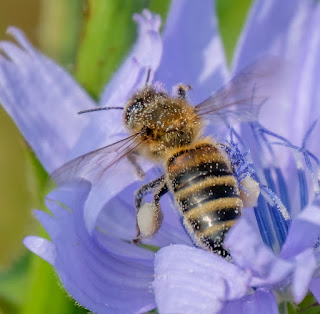A second batch of images from yesterday's visit - mainly to see if John agrees with the IDs. Short-winged Conehead, Field Grasshopper, Dock, Green and Spiked Shieldbugs, Kite-Tailed Robber fly, Flesh Flies mating, Cranefly, Big-Headed Flies (Pipunculidae), Fever flies and Frog!
Friday, September 1, 2017
Redgrave and Lopham Nature Reserve Suffolk I
A couple of posts from a CCC visit to this Suffolk NR. We were pleased to find a good variety of insects to photograph including Migrant Hawker mating, Common blue Damselfly, Emerald Damselfly, Ruddy Darter Male (reddish thorax and plain legs) and Common Darters mating and very confiding female (Brown thorax with yellow patches in female and yellow stripes on legs).
Also included a couple of Small Copper butterflies showing themselves off on thistledown
Wednesday, August 30, 2017
'Curiouser and curiouser' -Through the Lenses in Our Garden
First a Common Darter that has perished in the pond and is being consumed by all stages of Pond Skaters from very small juveniles to an unusual trio - the top one couldn't reach the prey so this did not last long.
The Leaf-cutter Bees have made holes in all our rose bushes and are busy stuffing their nest tubes with leaves. They glue them together with saliva in order to build the 'cells'. Each cell contains a ball or loaf of stored pollen and a single egg. The larvae hatch and develop, pupating in autumn and hibernating over winter.
Even more curious is this fly found when photographing a bee wrapped in a Garden Spider web. It belongs to the Milichiidae family (Jackal Flies). The adults of some species act as kleptoparasites, feeding on bodily fluids of the prey of various invertebrates including spiders. They penetrate the thinnest cuticle of a bee in a spider's web, extracting tissues that the enzymes in the venom of the spider have reduced to a fluid state. The "jackal" habit has been widely documented, with many pictures and references to Millichiidae assembling on the prey of spiders. However, they are fussy and most prey insects do not attract Milichiidae - they seem only to follow the scents exuded by killed prey such as Hemiptera, Heteroptera, and Hymenoptera. It is suggested that their chosen 'host' hunt prey that release a dramatic and characteristic olfactory signal. In support of this, some species seem to operate in the dark, and photographs of approaching flies seem to show them flying upwind. I haven't found any information on how they avoid getting stuck to the web!!
Monday, August 28, 2017
Flying Bees and Friends at Barton
A few insects from an early visit to Barton. Honeybees were busy collecting different coloured pollen from flowers while Hoverflies and Common Blue butterflies were getting on the wing. Particularly liked the colours of the Geometrid caterpillar and the small Hemipteran bug.
Sunday, August 27, 2017
Rugby Preseason Bishop's Stortford v. Cambridge Rugby Union Football Club
It was good to get the Canon gear out for a change and the weather was perfect with slightly hazy sunshine for most of the time. The 400mm lens was a bit long for some shots but is a great length for isolating the action. CRUFC managed a narrow victory with plenty of tries on both sides.
Saturday, August 26, 2017
Hummingbird Hawkmoth and Flying Companions at Gamlingay Wood
There were plenty of insects on the wing on a warm still afternoon at Gamlingay Wood including this Hummingbird Hawkmoth (too brief a visit to get more than half a dozen shots), three Volucella Hoverfly species and lots of butterflies. I tried to get out-of-focus backgrounds with the Red Admirals and Commas.
Subscribe to:
Posts (Atom)




















































